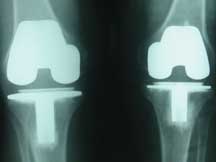Knee Replacement or Arthroplasty
In severe knee arthritis, joint restoration may not be feasible. If the entire knee is involved unicompartmental knee replacement is also not possible. In such cases total knee replacement provides reliable pain relief and improved function.
 Definition of knee arthroplasty:
Definition of knee arthroplasty:
This commonly means resurfacing the knee joint with components of plastic and metal. The diseased joint surfaces are cut away and artificial surfaces are inserted instead, usually with bone cement.
Differentiating when to use total knee arthroplasty versus unicompartmental knee arthroplasty:
Total knee arthroplasty resurfaces both the inner and outer (medial and lateral) compartments, and usually the patellar (kneecap) compartment. Unicompartmental knee arthroplasty resurfaces only the medial or lateral compartment but not both. The patella is not resurfaced. Total knee arthroplasty is used for globally arthritic knees.Unicompartmental knee arthroplasty is used for knees with arthritis in only one compartment.
Differentiating results between total knee arthroplasty and unicompartmental knee arthroplasty:
Total knee arthroplasty is a reliable procedure with an expected longevity of 10 to 15 years and sometimes longer. Unicompartmental knee arthroplasty results are often good but overall have been less predictably successful than total knee arthroplasty. Unicompartmental knee arthroplasty results are expected to last about 10 years. Unicompartmental knee arthroplasty is best thought of as a more conservative bridge in younger patients (usually in their 50’s), enabling them to put off total knee arthroplasty until they are at a more appropriate age, usually over 65 years. Unicompartmental knee arthroplasty sacrifices less bone than total knee arthroplasty.
Success rate:
Greater than 90% of all patients experience greatly reduced pain and increased function for more than 10 years after the procedure. However, there can be some serious complications. Infection occurs in about two percent of patients and requires removal of the knee replacement and re-replacement. Some patients, for unknown reasons, do not experience a satisfactory reduction in pain. Stiffness can be encountered. Problems with the kneecap, dislocation and fracture, as well as patellar tendon avulsion can also occur. In time many knee replacements loosen and become painful. They must then be revised to a new prosthesis. In the process more bone is removed. These revised arthroplasties on average have much less longevity than the first knee arthroplasty.
Requirements for candidates:
Persons with severe symptoms for whom less invasive procedures have failed or for whom they cannot be performed can be greatly helped by knee arthroplasty. It is a much better procedure for older patients who can expect to have it for the rest of their lives than for younger patients who will likely experience an eventual failure and require a revision.









